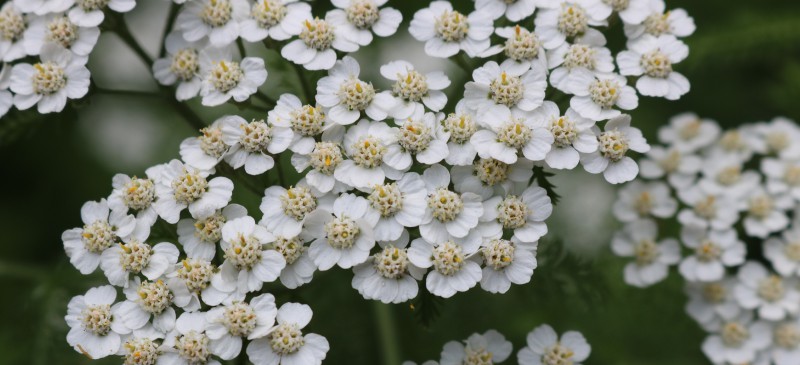
Yarrow, a flower in the sunflower family that’s closely related to chamomile and chrysanthemum, has been used since ancient times by cultures around the world. Traditionally, it’s been consumed as tea, applied to the skin or even cooked with in order to reduce inflammation (especially in the digestive tract), help treat skin wounds, and relieve anxiety and insomnia.
While you’ve probably never heard of this plant before, centuries ago it was actually a very popular vegetable. Back in the 17th century, the leaves were commonly prepared and consumed like spinach.
However, today it’s mostly an underutilized plant, despite its many benefits.
Do you like tarragon? Yarrow has a similar flavor profile and can be used in place of tarragon in recipes.
With a sweet, yet bitter flavor, not only does it make recipes more interesting, but it boosts the antioxidant content too.
What Is Yarrow?
Yarrow (Achillea millefolium) is a perennial plant from the Asteraceae family. It’s the best-known species of the genus Achillea due to its various therapeutic uses in both folk and conventional medicine.
The achillea millefolium plant is native to temperate regions of the Northern Hemisphere, including North America, Europe and Asia. It has fern-like foliage and colorful flowers of red, pink, salmon, yellow and white.
How tall does yarrow grow? Most plants grow to be two to four feet tall.
In the wild, you’ll usually see white yarrow and yellow yarrow.
Other common names for this plant include:
- common yarrow
- devil’s nettle
- gordaldo
- milfoil
- nosebleed plant
- old man’s pepper
- old man’s mustard
- sanguinary
- soldier’s woundwort
- thousand-leaf
- thousand-seal
Cerise queen is a bright pink variety. Achillea filipendulina, also known as fern-leaf yarrow, is a variety native to Caucasus, Iran and Afghanistan.
The flowers, leaves and stems are collected when the plant blooms. You can actually eat a yarrow flower and steep it to make tea.
The flowers and leaves are rich in nutrients and phytonutrients, the chemical compounds that occur naturally in plants.
Studies show that some of the plant’s health-promoting and anti-inflammatory phytochemicals include flavonoids, carotenoids and terpenes. Examples of antioxidants that have been isolated from the plant include:
- luteolin
- apigenin
- casticin
- centaureidin
- artemetin
- sesquiterpenoids
- paulitin
- isopaulitin
- desacetylmatricarin
- psilostachyin
A 2013 study published in Food Chemistry showed that commercial yarrow has more fat and saturated fatty acids, proteins, energy value, sugars and flavonoids, while wild yarrow has higher levels of carbohydrates, organic acids, unsaturated fatty acids, tocopherols and phenolic acids.
Health Benefits
1. Helps Protect Skin and Treat Wounds
Yarrow has been employed for natural wound treatment for centuries.
Why is yarrow good for your skin? According to studies, it possesses anti-inflammatory agents that have a positive impact on the skin pH and moisture content.
In addition, it’s a natural antiseptic so it can prevent wounds from getting infected. This is why many healing ointments include yarrow as a key ingredient.
The chemical achilleine present in this plant is also known for its ability to stop bleeding. In powdered form, studies show it can be sprinkled on wounds to not only stop bleeding, but also to dull pain.
It may help treat widespread skin conditions as well, including hemorrhoids, rashes and slow-healing broken skin.
Some studies have even demonstrated that yarrow oil can provide wound healing from napalm (a flammable liquid used in warfare) burns.
2. Potential Amenorrhea Aid
Surprisingly, yarrow has also been used in traditional herbal medicine to actually encourage bleeding in certain health conditions. One of these health issues is amenorrhea, which is an abnormal absence of menstruation.
Yarrow, rue, motherwort and partridge berry are herbal emmenagogues.
As an emmenagogue, achillea millefolium can help stimulate blood flow in the pelvic area, as well as the uterus, and encourage menstruation. Unfortunately, this usage has not yet been confirmed by clinical research, though it’s been utilized in this way for centuries.
3. Has Mild Sedative Effects for Sleep and Anxiety
Trying yarrow is a good option for those who struggle with anxiety and insomnia.
A 2012 study published in the Journal of Ethnopharmacology looked at the sedative and anti-anxiety effects of yarrow in animal models. Researchers used a hydroalcoholic extract from the aerial parts of yarrow on animal subjects in open-field tests.
They found that it had anti-anxiety effects after both short-term and long-term administration to subjects.
Furthermore, they found that the yarrow had an effect similar to diazepam (Valium), which is a common prescription for anxiety issues. The study also showed that it remained effective after short-term, repeated administration.
4. Can Help Reduce Inflammation and Support Immune Function
Traditional herbal medicine in China, Europe and India has used this herb to calm inflammation for a variety of health issues, especially inflammation in the intestines and female reproductive tract. Extracts have been shown to have anti-inflammatory properties.
Researchers believe that yarrow’s ability to quell inflammation is related to the fact that it contains both flavonoids and sesquiterpene lactones. The herb displays not only anti-inflammatory abilities, but also astringent properties.
This is why it’s often included in topical products for inflammatory skin problems like eczema.
READ RELATED: Chrysanthemum Tea: An Antioxidant Drink to Boost Your Health
Yarrow has also been used in folk medicine to treat fevers, colds and the flu.
5. May Help Naturally Treat Mastitis
Yarrow has been found to be really helpful for women suffering from mastitis. Mastitis is a breast infection that mostly occurs among women who are breastfeeding.
Specifically, leaf poultices made with the leaves provide almost instantaneous pain relief and help treat sore, cracked nipples. When you have mastitis, it’s a smart idea to alternate between warm and cold compresses since cold helps relieve pain while warmth increases circulation.
Additionally, this herb contains anti-inflammatory and antibacterial compounds.
6. Offers Gastrointestinal Benefits
The antispasmodic activity of yarrow makes it useful for unwanted gastrointestinal concerns like diarrhea, flatulence and cramping. Animal studies have uncovered evidence that it can reduce smooth muscle spasms that contribute to GI complaints and even inflammatory bowel diseases.
A. millefolium has been shown in studies to inhibit contractions of smooth muscle and to have a relaxatory effect on the GI system via several mechanisms, such as altering calcium channels, cholinergic receptors and nitric oxide production. Its antispasmodic ability is also most likely tied to the plant’s flavonoid fractions.
7. May Be Helpful for High Blood Pressure and Asthma
A 2013 study published in Phytotherapy Research evaluated Achillea millefolium‘s hypotensive, vasodilatory and bronchodilatory activities — in other words, its ability to lower high blood pressure, relax blood vessels and improve breathing. Yarrow’s effects on the study’s animal subjects backed up the medicinal use in hyperactive cardiovascular as well as airway disorders like asthma.
8. May Possess Anti-Tumor Properties
Recent animal studies suggest that yarrow extract exerts antitumoral properties by targeting lipid metabolism involved in the formation of pancreatic cancer. It has been shown to help activate regulatory pathways and promote malignancy in pancreatic cancer.

Uses
What is the herb yarrow used for? As explained above, some of the most popular uses include treating:
- inflammatory skin conditions
- indigestion and GI issues
- anxiety
- insomnia
- menstrual symptoms
- allergies
- cardiovascular/respiratory issues
Yarrow uses in cooking include the following:
- Younger leaves can be used in soups or stews similar to how you would use a delicate leafy green like spinach.
- Substitute it for tarragon in recipes.
- For sautéed dishes, add it at the very end.
- Use it to make infused vinegars and oils.
- Fresh, young flowers can be used in salads.
- Historically, it’s also been used to make liquor and bitters.
The flavor of yarrow is sweet but also somewhat bitter with an anise-like scent. It’s often compared to tarragon.
When using it in cooked dishes, keep in mind that it’s a soft herb and high heat destroys its flavor.
Where can you buy yarrow? It should be available at your local health store or online in the following forms:
- fresh herb or flower
- dried herb
- capsule
- tablet,
- tincture
- liquid extract
- tea
You also may be able to find fresh yarrow flowers in the wild depending on where you live.
A typical dose of the herb is 4.5 grams per day for inflammatory issues. However, there are no modern clinical studies to confirm this dose, so it’s best to speak with a professional on proper dosing for your particular needs.
How to Make Yarrow Tea
Yarrow flowers, leaves and stems can be used to make a medicinal tea. You can use either the fresh or dried flower/leaves.
Yarrow tea can taste bitter so you can use honey to take the edge off if needed.
Many tea recipes include lemon, which gives a nice boost of vitamin C. Try also combining yarrow with echinacea, elder flower, ginger,and peppermint for additional respiratory and digestive-soothing effects.
Homemade Yarrow Tea Recipe:
INGREDIENTS:
- 1 teaspoon dried yarrow or 3 fresh leaves
- 1 cup boiling water
- 1 teaspoon honey (optional)
- 1 lemon slice (optional)
DIRECTIONS:
- Steep yarrow in boiling water for 10 minutes. Remove leaves if desired.
- Add honey and/or lemon juice if desired.
- Stir.
Risks, Side Effects and Interactions
When taken by mouth, yarrow can possibly cause drowsiness and increased urination. Topically, it may cause contact dermatitis or skin irritation.
Discontinue use if you see signs of irritation.
If you’re allergic to plants in the Aster family, like ragweed and daisies, then you may likely be allergic to external and internal use of this herb, so be careful. It can make skin more sensitive to sunlight.
Is yarrow ever poisonous to humans? It’s not generally considered toxic, but be careful when using the oil because it contains thujone in small amounts.
Also found in wormwood, thujone is toxic in large amounts and has a narcotic effect on the brain.
This herb also contains coumarin, which has blood-thinning abilities. This is why it should not be combined with prescription blood thinners.
It should not be used by pregnant women. If you’re breastfeeding, speak with your doctor before using yarrow products.
It’s not commonly recommended for pediatric use due to a lack of studies to determine whether or not its usage is safe in children. Speak with your child’s doctor if you’re interested in using it with your child.
It can possibly interact with the following medications as well:
- Blood thinners (like warfarin)
- Lithium
- Stomach acid-reducing medications (like omeprazole)
- High blood pressure medications
- Drugs that cause sleepiness (like anticonvulsants and sleeping pills)
Speak with your doctor before taking yarrow if you have a history of any chronic diseases or take any medications regularly.
Conclusion
- Yarrow (achillea millefolium) is a plant that’s been used as food and medicine since ancient times.
- Human clinical studies are lacking when it comes to its use, but there is a long history of traditional usage as well as anecdotal evidence and animal studies to support its medicinal usage.
- The most popular yarrow uses include helping treat inflammatory skin conditions, indigestion and GI issues, anxiety, insomnia, menstrual symptoms, allergies, and cardiovascular/respiratory issues.
- It also has a place in your kitchen and can be used to make tea or in place of tarragon in recipes.
Source: Dr. Axe | Nutrition






